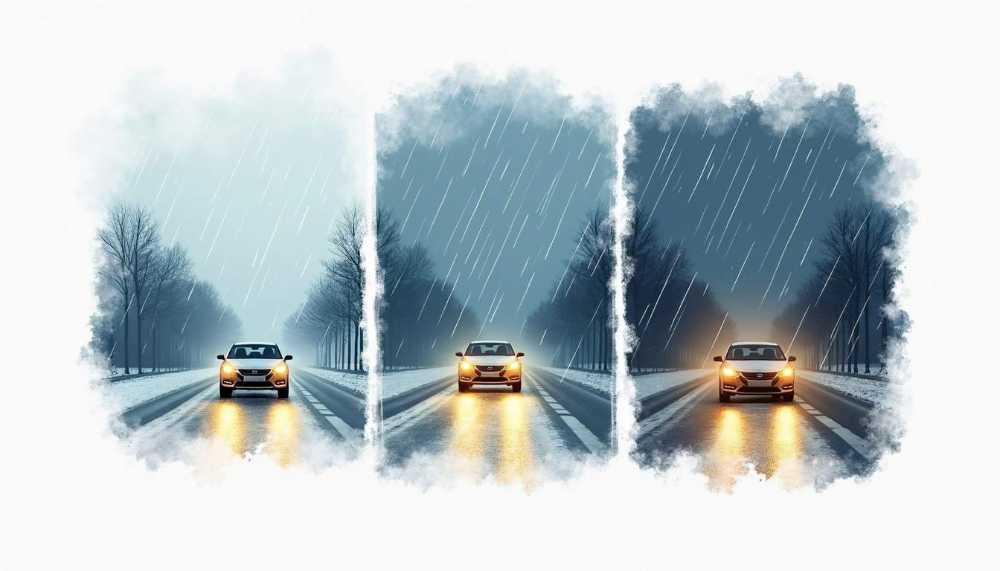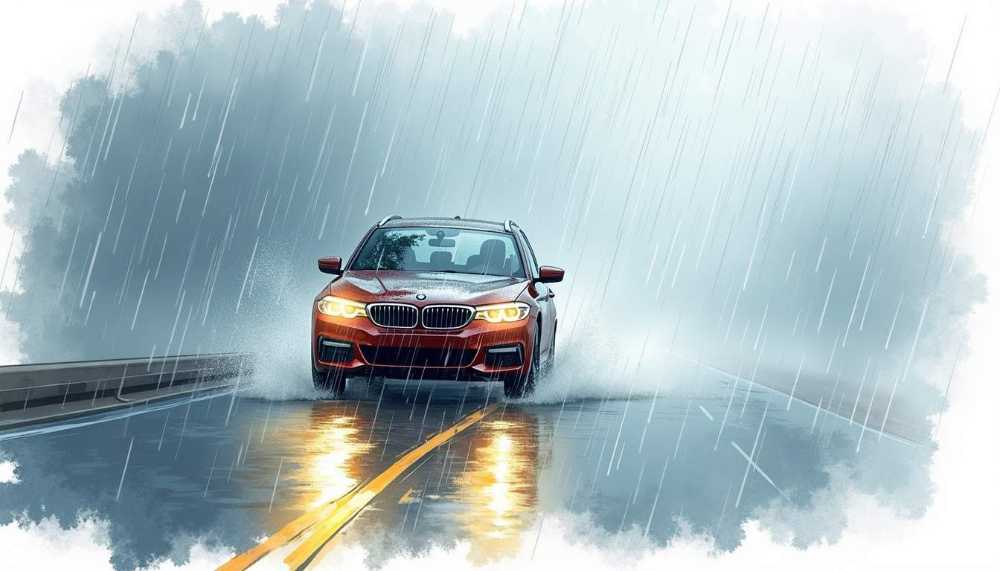Driving conditions can change rapidly, posing unique challenges to visibility and safety. Proper headlight use is crucial not just for illuminating the road ahead but also for ensuring that you navigate various environmental conditions effectively. This guide explores the importance of proper headlight usage, focusing on fog, rain, and night driving.
Understanding the Importance of Proper Headlight Use
Headlights are essential for safe driving, especially when visibility is compromised. According to the National Highway Traffic Safety Administration, a significant percentage of accidents occur in low visibility conditions. Drivers must understand how to use their headlights properly to mitigate risks.
Using hea
Safety Implications of Headlight Usage
Failing to use headlights appropriately can lead to serious consequences. Inadequate lighting may result in the driver being unable to see obstacles, other vehicles, or pedestrians until it’s too late. Moreover, if headlights are not functioning correctly, drivers may inadvertently cause accidents by failing to signal their presence to others. This is particularly concerning in urban areas where pedestrians and cyclists are prevalent, as they rely heavily on the visibility of vehicles to ensure their own safety.
Additionally, the type and condition of headlights can affect their performance. For instance, dull or yellowed lenses can scatter light, further reducing visibility. Regular maintenance is crucial to counteract these issues. Drivers should routinely check their headlights for clarity and brightness, as well as ensure that they are aligned correctly. Misaligned headlights can blind oncoming traffic and reduce the effectiveness of the light beam, leading to dangerous driving conditions.
Enhancing Visibility for Different Driving Conditions
Different driving conditions necessitate different headlight settings. For example, during rainy conditions, using high beams can create glare that reflects off the precipitation, making visibility worse. In contrast, fog lights are specifically designed to cut through fog, rain, or snow. Understanding the functionality of these lights can empower drivers to make informed decisions that enhance their safety on the road.
Understanding when and how to use these various types of lights ensures optimal visibility. Tailoring headlight usage to current driving conditions can significantly enhance both driver and passenger safety. Furthermore, modern vehicles often come equipped with automatic headlight systems that adjust based on ambient light levels. However, drivers should remain vigilant and override these systems when necessary, such as during severe weather or when driving through poorly lit areas. Being proactive about headlight use not only protects the driver but also contributes to the overall safety of the roadways, fostering a more secure environment for everyone.
Navigating Through Fog with the Right Headlights
Fog presents unique challenges for drivers, often reducing visibility to mere feet. In such conditions, it is essential to have the right lighting in place. Navigating safely through fog requires clear and functional fog lights, which can illuminate the road immediately in front of the vehicle without causing too much glare.
Types of Fog Lights and Their Uses
Fog lights come in various designs, including halogen, LED, and HID lights. Halogen fog lights generally provide a yellowish light that penetrates fog and rain effectively. LED fog lights, while brighter, can sometimes create glare if not aimed correctly. HID lights, known for their intense brightness, are less commonly used for fog due to their tendency to scatter light in the mist, which can further impair visibility.
Understanding the purpose of fog lights versus traditional headlights is crucial. Fog lights are designed to provide a wide and short beam of light that helps illuminate the road immediately before the vehicle, minimizing the light that reflects back from moisture in the air. This specialized lighting is particularly useful in dense fog, where standard headlights can create a wall of light that reflects off the fog, making it even harder to see.
Tips for Using Fog Lights Effectively
To maximize the effectiveness of fog lights, drivers should turn them on only when visibility is significantly reduced. They should not be used in clear weather conditions, as this could blind other drivers. It's also important to remember that fog lights should complement, not replace, standard headlights. When driving in fog, a combination of both can provide the best visibility without overwhelming other road users.
Additionally, maintaining fog lights is key. Regular cleaning to remove dirt and grime, as well as checking the alignment, ensures they function correctly and provide adequate illumination when needed. Drivers should also be aware of the legal regulations regarding fog light usage in their region, as improper use can lead to fines. Furthermore, understanding the weather conditions can also play a role; for instance, in heavy rain or snow, the effectiveness of fog lights may diminish, and drivers should adjust their lighting accordingly to ensure safety.
Ensuring Clear Vision in Rain with Suitable Headlights
Driving in rain presents another set of challenges that can affect visibility. Drivers need to ensure their headlights are functioning optimally to see and be seen during such conditions. Rain can cause water to accumulate on the road, reflecting light and creating hazardous driving environments. The combination of wet surfaces and reduced visibility can lead to an increase in accidents, making it essential for drivers to be proactive about their lighting systems
While standard headlights can be used in the rain, some vehicles are equipped with specific rain light features designed to improve visibility when weather conditions worsen. These lights often automatically adjust their brightness based on the intensity of the rainfall. This means that as the rain intensifies, the headlights will shine brighter, cutting through the water droplets and illuminating the road ahead more effectively. Additionally, some advanced systems utilize adaptive lighting technology that can pivot the headlights in the direction of the steering wheel, providing better illumination around curves and corners.
Using the correct lighting can significantly impact how well you can see through rain. Some drivers may also opt for high-performance bulbs that offer better visibility than standard bulbs. These bulbs can produce a whiter light, which is more effective at penetrating rain and fog, thus enhancing overall visibility. Furthermore, LED headlights are becoming increasingly popular due to their longevity and efficiency, providing a brighter beam that can help illuminate the road in adverse weather conditions.
Strategies for Optimal Headlight Use in Rain
When driving in the rain, drivers should switch on their headlights even during the day to increase visibility. It is also advisable to avoid using high beams, which can create glare and make it harder to see. Instead, low beams are recommended as they provide adequate illumination without reflecting off the rain and back into the driver’s eyes. It’s also important to remember that rain can cause other drivers to misjudge distances and speeds, so having your headlights on can help others see you better, reducing the risk of collisions.
Regularly checking the condition of your headlights is also crucial. Ensuring that the lenses are clear and that the bulbs are functional can make a significant difference in rainy conditions. Over time, headlight lenses can become foggy or discolored due to UV exposure and environmental factors, which diminishes their effectiveness. Consider using a headlight restoration kit to maintain clarity and brightness. Additionally, keeping your windshield wipers in good condition is equally important; they work in tandem with your headlights to ensure you have the best possible visibility while navigating through rain-soaked roads.
Mastering Night Driving with Appropriate Headlights
Night driving poses its own set of challenges. Poor visibility can lead to accidents, making it essential to master the use of headlights after sunset. Proper headlight use can substantially improve visibility and safety during nighttime driving.
The RMastering Night Driving with Appropriate Headlightsole of Headlights in Night Driving
Headlights are the primary source of illumination at night. They can reveal potholes, pedestrians, and other vehicles that might be difficult to see in the dark. High and low beams serve different purposes; low beams are designed for regular driving conditions, while high beams are meant for use on dark roads without oncoming traffic.
It’s vital to adjust your driving habits when using high beams, ensuring you dim them appropriately for oncoming traffic. This practice prevents blinding others and enhances everyone’s safety on the road.
Selecting and Using Night Driving Headlights
Choosing the right type of headlights can also affect your night driving experience. Longer-lasting LED headlights are becoming popular due to their bright output and extended lifecycle. However, drivers should also consider the quality and aim of the lights to avoid glare and ensure full road coverage.
Using headlights effectively at night also calls for regular maintenance. Dimming headlights when they are no longer needed and cleaning lenses to ensure optimal visibility can enhance both driver comfort and safety.
Maintenance Tips for Your Headlights
Regular maintenance of your headlights is crucial to ensure that they function correctly. Poorly maintained headlights can lead to dangerous situations, especially in low visibility conditions such as fog, rain, or nighttime driving.
Regular Cleaning and Inspection
It's advisable to clean your headlight lenses regularly. Dirt and grime can diminish their effectiveness. Additionally, inspecting the bulbs for wear and tear is essential—dim lights are often a sign that a bulb is nearing the end of its life.
Take the time to adjust headlights as necessary to ensure they focus correctly on the road ahead. Misaligned headlights can pose a significant hazard to both the driver and other road users.
When to Consider Headlight Replacement
It’s important to consider headlight replacement if you notice any dimness, discoloration, or if they flicker unexpectedly. The typical lifespan of headlight bulbs varies by type, but it’s generally good practice to replace them every couple of years or sooner if performance noticeably declines.
Consulting a professional mechanic for advice on the best types of bulbs for different conditions can also be beneficial. Investing in the right headlights tailored to specific driving scenarios enhances safety and improves the overall driving experience.












